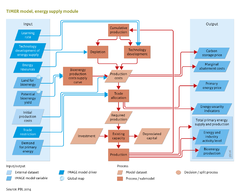Energy supply/Description: Difference between revisions
Jump to navigation
Jump to search
No edit summary |
m (Text replace - "Crop and grassland model" to "Crop and grass") |
||
| Line 18: | Line 18: | ||
The structure of the biomass sub-model is similar to that of the fossil-fuel supply models, but with a few important differences ([[Hoogwijk, 2004]]) (***see Figure 4.1.3.1b). | The structure of the biomass sub-model is similar to that of the fossil-fuel supply models, but with a few important differences ([[Hoogwijk, 2004]]) (***see Figure 4.1.3.1b). | ||
* Depletion in the bio-energy model is not governed by cumulative production, but by the degree to which available land is being used for commercial energy crops. | * Depletion in the bio-energy model is not governed by cumulative production, but by the degree to which available land is being used for commercial energy crops. | ||
* The total amount of potentially available bio-energy is derived from bio-energy crop yields calculated on a 0.5 by 0.5 degree grid with the [[Crop and | * The total amount of potentially available bio-energy is derived from bio-energy crop yields calculated on a 0.5 by 0.5 degree grid with the [[Crop and grass|IMAGE crop model]] for various land-use scenarios for the 21st century. Potential supply is restricted on the basis of a set of criteria, most importantly the condition that bio-energy is only allowed on abandoned agricultural land and on part of the natural grasslands. The costs of primary bio-energy crops (woody, maize and sugar cane) are calculated with a Cobb-Douglas production function using labour costs, land rent costs and capital costs as input. The costs of land are based on average regional income levels per km2, which was found to be a reasonable proxy for regional differences in land rent costs. The production functions are calibrated to empirical data as mentioned ([[Hoogwijk, 2004]]). | ||
* Next, the biomass model describes the conversion of biomass (including residues, in addition to wood crops, maize and sugar cane) to two generic secondary fuel types: bio-solid fuels and bio-liquid fuels. The solid fuel is used in industrial and power sectors and the liquid fuel mostly in the transport sector. | * Next, the biomass model describes the conversion of biomass (including residues, in addition to wood crops, maize and sugar cane) to two generic secondary fuel types: bio-solid fuels and bio-liquid fuels. The solid fuel is used in industrial and power sectors and the liquid fuel mostly in the transport sector. | ||
* The trade and allocation of biofuel production among regions is determined by optimisation. In this way, an optimal mix of bio-solid and bio-liquid fuel supply across regions is calculated, using the prices of the previous time step to calculate their demand. | * The trade and allocation of biofuel production among regions is determined by optimisation. In this way, an optimal mix of bio-solid and bio-liquid fuel supply across regions is calculated, using the prices of the previous time step to calculate their demand. | ||
Revision as of 17:21, 11 December 2013
Parts of Energy supply/Description
| Component is implemented in: |
|
| Related IMAGE components |
| Projects/Applications |
| Key publications |
| References |
